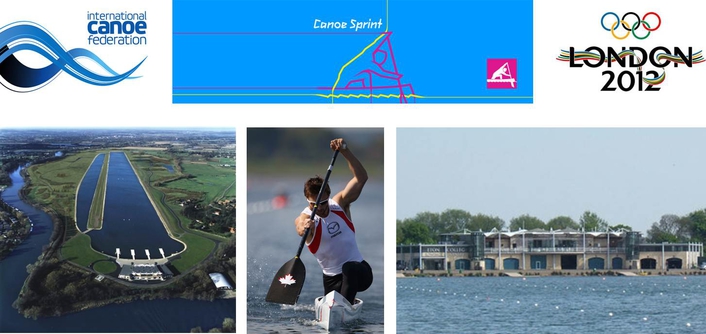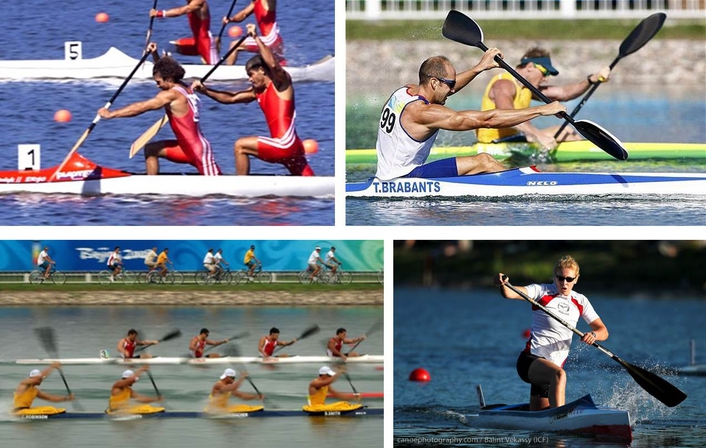Olympic Games 2012: Canoe Sprint
posted:
Two styles of boats are used in this sport, canoes with 1 or 2 canoers and kayaks with 1, 2 or 4 kayakers. This leads to the name designation of each event. For example, "C-1" is a canoe singles event and "K-2" is a kayak doubles event. Races are usually 500 metres or 1000 metres long, although there were also 10 km events from 1936 to 1956. On 13 August 2009, it was announced by the International Canoe Federation that the men's 500 m events would be replaced at the 2012 Summer Olympics by 200 m events with one of them being K-1 200 m for the women. The other events for men at 200 m will be C-1, C-2, and K-1. This was confirmed at their 2009 Board of Directors meeting in Windsor, Berkshire, Great Britain on 5 December 2009.
History
The word kayak, meaning “man-boat” in Eskimo, was found predominately in North America, Siberia and Greenland. They were ideal for individual transport and were used primarily for hunting and fishing. The canoe, on the other hand, was used on a wider scale. From Native American tribes to the Polynesians, the canoe had a variety uses, primarily transport, trade and warfare. The basics of Canoe sprint are simple.
The histories of the canoe and the kayak go back hundreds of years, but it wasn’t until the middle of the 19th century that the first official canoe and kayak races were held. The sport now takes two forms, the oldest of which is the power-packed, fiercely competitive Canoe Sprint discipline.
advertisment
Intrepid Scottish barrister, John MacGregor was the first European to use an Inuit Kayak for tourism and excursion purposes, he also formed the first-ever kayak club “The Royal Canoe Club of London” on the 25 July 1866 in London. The first Canoeing competition, organised by MacGregor, was held in 1869. In 1871 the “New York Canoe Club” was established. The first women’s competition was organised in Russia. By the 1890s, canoe sport was popular all over the European continent.
advertisment
Under the auspices of the Internationale Repräsentantenschaft Kanusport (IRK), which was formed in January 1924 in Copenhagen, the first European Championships were held on the 19 August 1933 in Prague. Canoeing first featured as a demonstration sport at the 1924 Paris Games. On the 16 May 1934 the International Olympic Committee approved the appearance of the sport of Canoeing at the Olympic Games and this was realised in 1936 at the XI Olympic Games held in Berlin when races were held over of 1,000m and 10,000m. Since then, the Olympic events have grown shorter: the last long-distance events were held at the Melbourne Games of 1956. the Women’s category was added to the Olympic programme in 1948.
The Basics
Canoe Sprint events are head-to-head races conducted on still water, as opposed to the white water time trials of the Canoe Slalom competition. Athletes race over distances of 200m, 500m or 1,000m, either solo, in pairs or in teams of four.
As in slalom canoe, the competition is divided into two classes: the kayak, in which competitors are seated in the boat and can use both ends of the paddle, and the canoe, in which competitors kneel and use a single-bladed paddle to propel themselves.
advertisment
Athletes race over distances of 200m, 500m or 1,000m, either solo, in pairs or in teams of four. Each event is defined by a code, such as K2 (K for kayak, two for the number of people in each canoe).
As an outdoor sport weather can affect the outcome of a race. Choppy, as opposed to still or calm, water and windy conditions can make a race more physically gruelling and harder to negotiate.
advertisment
Nine canoes, all in a row, racing along a straight, still stretch of water. First to the line wins.
Paradoxically, it is one in which the big Olympic powers – America, China and Russia – have had comparatively little success in recent years. Central and eastern Europe are currently the powerhouses of the sport.
The major change from Beijing is the replacement of the men’s 500-metre races with the more explosive 200m races. Women, however, will still race over 500-metres except the kayak single.
The Format
For London 2012, the Canoe Sprint competition will be held at Eton Dorney, one of the best still-water courses in the world with a wonderful location close to Windsor Castle. Races will be held over distances of 1,000m, 500m and, for the first time at the Games, 200m: with the fastest races taking just 30 seconds to complete, it’s bound to be very popular with spectators and athletes alike.
The programme for London 2012 will consist of 12 events, eight for men and four for women. The 200m events will be an Olympic feature in London for the first time in the Women’s and Men’s K1 and the Men’s C1. Women will race over 500m in the K1, K2 and K4 and Men will race over 1000m in the K1, K2, K4 and C1 and C2. On the whole, Europe has dominated the sport, winning over 90% of all available medals.
advertisment
The most successful Olympic competitor is the German Birgit Fischer who in her long Olympic career between 1980 and 2004 won 8 gold and 4 silver medals. Her achievements mark her as both once the youngest- (aged 18) and oldest-ever (aged 42) Olympic Canoe Champion. Birgit also won 28 World Championship Golds, 6 silver and 4 bronze medals throughout her career.
Despite its relatively low profile, canoeing is one of the more lucrative Olympic pursuits, with 12 gold medals to be won.
advertisment
Key facts
Events/Discilpins: C1 Men’s canoe single 1,000 metres; C2 Men’s canoe double 1,000 metres; K1 Men’s kayak single 1,000 metres; K2 Men’s kayak double 1,000 metres; K4 Men’s kayak four 1,000 metres; C1 Men’s canoe single 200 metres; K1 Men’s kayak single 200 metres; K2 Men’s kayak double 200 metres; K4 Women’s kayak four 500 metres; K1 Women’s kayak single 500 metres; K2 Women’s kayak double 500 metres; K1 Women’s kayak single 200 metres
Venue: Eton Dorney
Dates: Monday 6 – Saturday 11 August
Medal events: 12
Athletes: 248






